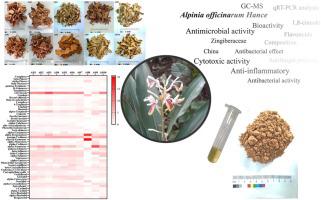Industrial Crops and Products ( IF 5.6 ) Pub Date : 2020-05-28 , DOI: 10.1016/j.indcrop.2020.112583 Lanyue Zhang , Chunxing Pan , Zhirong Ou , Xiaoxin Liang , Yaohui Shi , Lejing Chi , Zejun Zhang , Xi Zheng , Chunlian Li , Hongping Xiang

|
Essential oil of herbs has natural bioactivity, which can be applied on biomedical products, pharmaceutical preparations, natural functional nutrition and cosmetic additives. The chemical components and bioactivities of essential oils extracted from Alpinia officinarum Hance rhizomes collected from ten various habitats in China were comparatively investigated. The yield of ten essential oils varied from 0.93% to 4.35%. In total, 53 components were identified from GC–MS analysis, and the dominant compositions were 1,8-cineole (0.15–13.77%), α-farnesene (0.11–7.93%), γ-cadinene (2.30–6.95%), α-terpineol (0.28–5.67%), α-bergamotene (1.88–15.69%) and globulol (0.95–3.16%). The vast majority of these essential oils revealed outstanding anti-bacterial activities, especially against Gram-positive bacteria. According to 12-O-tetradecanoylphorbol-13-acetate (TPA)-induced mice ear edema assay, some essential oils displayed excellent anti-inflammatory properties through markedly down-regulating the relative expression of inflammatory cytokines, such as interleukin-1 beta (IL-1β) and tumor necrosis factor (TNF-α), and the essential oil of rhizomes collected from Yulin of Guangxi province showed the best anti-inflammatory effect. The antitumor activities of essential oils against microglial BV2 cell lines are also investigated, and many are quite excellent based on these IC50 values (211.07–769.06 μg/mL). Obviously, the results indicated majority of essential oils from A. officinarum rhizomes manifested extraordinary bioactivities, which makes them suitable to a large number of biomedical products, pharmaceutical preparations, natural functional nutrition and cosmetic additives.


















































 京公网安备 11010802027423号
京公网安备 11010802027423号